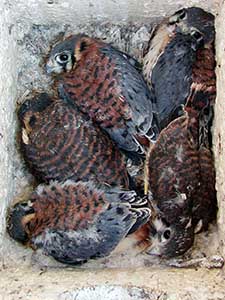
Master of Arts student, Department of Biology, College of William and Mary (1995-2002)
THESIS TITLE
Patch use of winter resident and migrant American Kestrels (Falco sparverius) in the Coastal Plain of Virginia
THESIS ABSTRACT
American Kestrels (Falco sparverius) are common throughout the Coastal Plain of Virginia except during the summer breeding season. Eight survey routes consisting of eighty-six 10 km road segments that varied according to the amount of available open habitat were surveyed by automobile. A total of 463 birds were recorded with an overall sex ratio of 58.9% males and 41.1% females. Winter surveys showed a skewed sex ratio favoring males, as did surveys conducted during spring migration. However, when divided into early and late survey rounds, spring sex ratio data supported differential timing of migration by sex, with males moving through earlier than females.
Male and female kestrels exhibited similar patterns of habitat use during all seasons. Kestrels were found to use both agriculture and idle grass areas significantly more than expected, while pasture, forest, and ‘other’ habitats were used significantly less than expected. Residential areas and clear-cuts were used according to their availability. Kestrels occupied much larger agricultural patches in winter compared to those occupied during migration. Small agricultural patches that were imbedded within landscapes containing open habitat complexes had a significantly higher probability of being occupied compared to isolated patches. Occupation rates were influenced during both winter and migration by the proportion of open habitat within a survey segment. This was a significant relationship in winter with the highest occupation rates occurring in areas with open habitats accounting for more than 70% of the landscape. A similar trend was observed in the migration period but was not statistically significant. Kestrel density showed a positive response across the landscape gradient in winter with an average density more than twice as high along segments with > 70% open habitat. Average density within the migration periods showed no detectable trend across the landscape gradient.
Kestrels in the Coastal Plain of Virginia showed a similar sex ratio and no differential habitat use between the sexes, which support similar findings at this latitude in Kentucky. Densities of kestrels within the study area seemed to be much higher than reports in other studies, with 0.41 observations/100 ha for open habitats in winter, 0.64/100 ha in spring, and 0.35/100 ha in fall.
Selection of habitat patches of greater size than predicted from the range of sizes available has not been demonstrated previously. It follows logically that kestrels would select patches using different criteria under varying seasonal conditions. This is supported by wintering kestrels rarely being sighted in agricultural patches with less than 800 m of road frontage. In contrast, these patches were used with some frequency during migratory periods.
